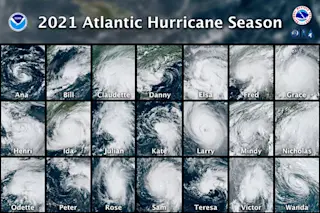The Atlantic Hurricane season officially came to a close today, and statistics just released by NOAA show that it was unusually active.
All told, of the season's 21 named storms, seven were hurricanes, and four of these had winds of 111 miles per hour or greater, qualifying them as major hurricanes.
During an average Atlantic season there are three major hurricanes.
For the record: A storm gets an official name when its winds reach 39 mph or greater. To qualify as a hurricane, it must reach 74 mph or more.
In terms of named storms, 2021 was the third most active year on record, according to NOAA. The year also ends as the sixth in a row with above-normal Atlantic hurricane activity.
As with last year, 2021 exhausted the list of 21 storm names — and that's the first time this has happened for two years running. This past year ...














